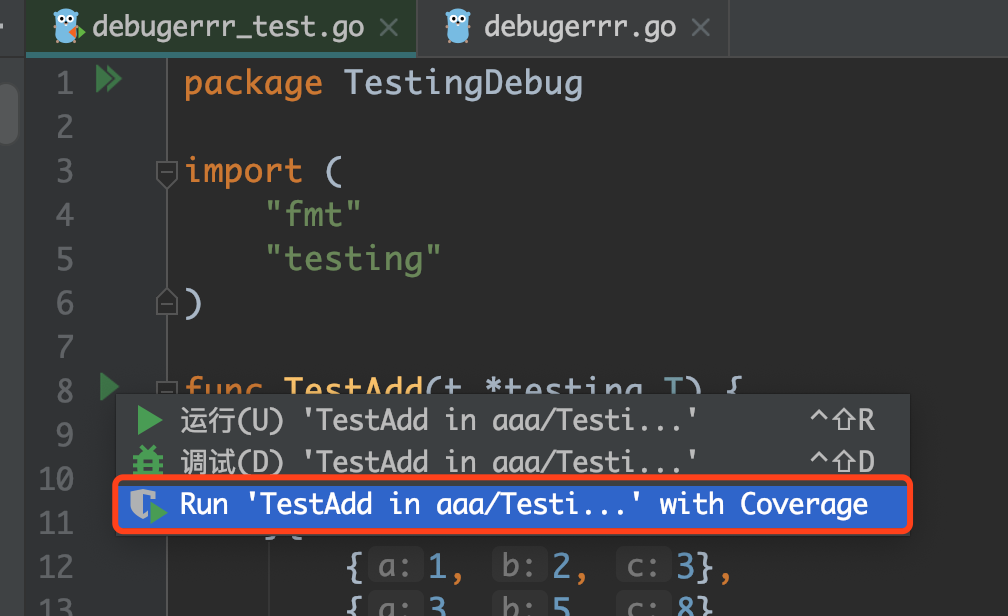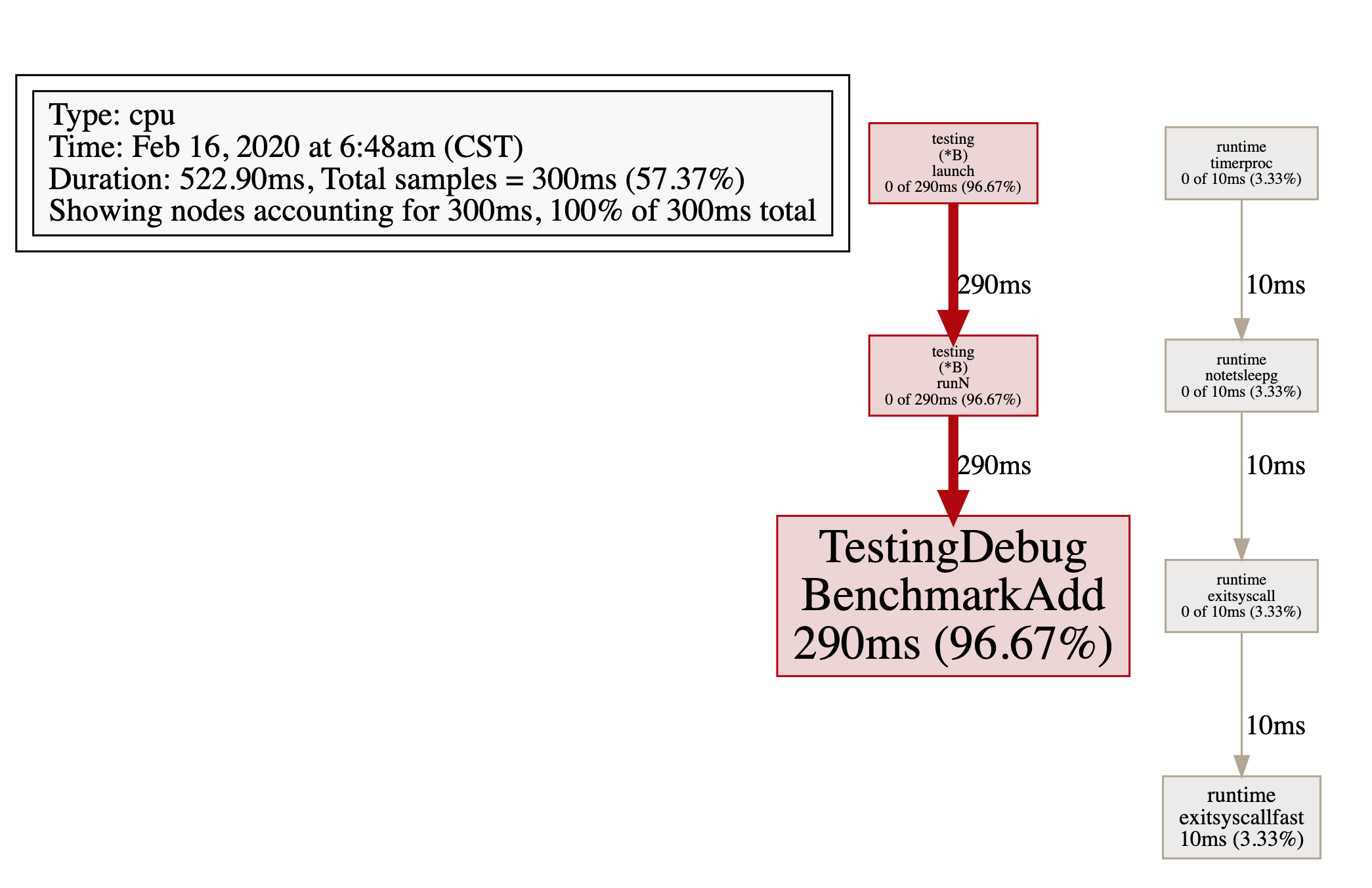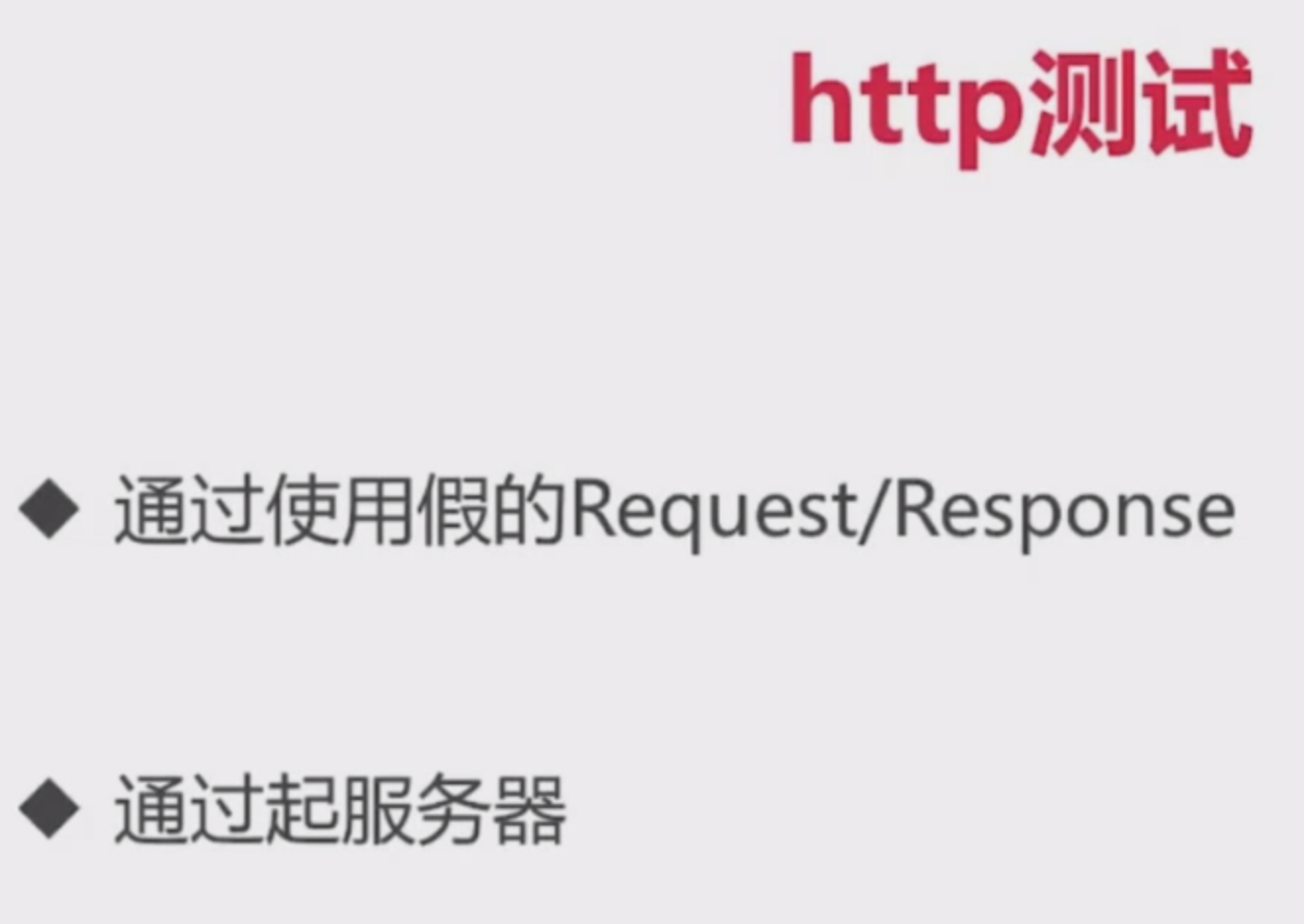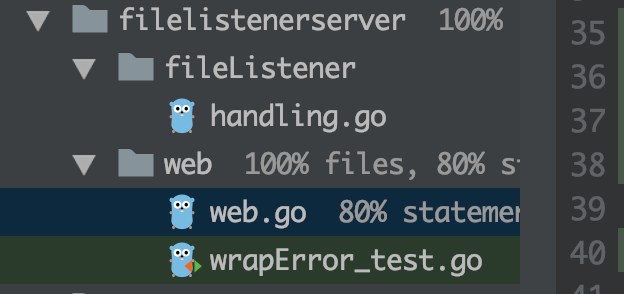一. go语言单元测试写法
1. 文件命令, 测试内容+ _test
2. 测试的方法名以Test开头. 参数为(test *Test)
3. 测试文件和源文件放在同一个目录中
例:
package TestingDebug func Add(a, b int) int { return b + a }
package TestingDebug import ( "fmt" "testing" ) func TestAdd(t *testing.T) { var test = []struct{ a, b, c int }{ {1, 2, 3}, {3, 5, 8}, {2, 4, 5}, } for _, tt := range test { if actural := Add(tt.a, tt.b) ; actural != tt.c { fmt.Printf("%d + %d, except:%d, actual:%d", tt.a, tt.b, tt.c, actural) } } }
需要注意几点
1. 同目录下文件相互调用, 不需要加包名
2. 测试文件与源文件在同一个目录下, 否则技术不出来测试代码覆盖率.
二. 如何测试代码覆盖率


然后点击TestingDebug进入文件夹, 点击测试的文件. 看右侧绿线, 表示测试覆盖的代码. 这里覆盖了100%

三. 性能测试BenchMark
性能测试使用Testing.B
比如, 我们想要测试一个复杂一些的数据的累加, 看看性能如何.
/** * 性能测试 */ func BenchmarkAdd(bb *testing.B) { var a, b, c int a = 123 b = 4557 c = 4680 for i := 0; i<bb.N ; i++ { if actural := Add(a, b) ; actural != c { fmt.Printf("%d + %d, except:%d, actual:%d", a, b, c, actural) } } }
bb.N表示的是系统自动计算的一个循环次数, 我们不用自己指定.
goos: darwin goarch: amd64 pkg: aaa/TestingDebug BenchmarkAdd-8 1000000000 0.317 ns/op PASS
以上是测试结果. 1000000000 代表测试的次数是10亿次. 0.317 ns/op每个操作执行的时间是0.317ns
四. 性能调优--使用pprof进行性能优化
如上一步, 我们对代码进行了性能测试. 每个操作执行时间是0.317ns. 那么, 假如有一个稍微复杂一些的例子, 我如何看出花费了这么多时间, 都是在哪个步骤花的? 哪个步骤耗费时间最多呢?
我们使用命令来看
go test -bench . -cpuprofile cpu.out
执行上面的命令生成一个cpu.out的文件, 查看cpu运行的情况

我们使用less查看文件: less cpu.out

cpu.out是一个二进制文件,我们没办法打开. 我们可以使用命令打开
go tool pprof cpu.out

这里我们可以通过pprof的web视图来查看到底那个步骤耗时最多. 但是看红色字, 查看web视图,需要安装一个软件Graphviz
安装Graphviz, 下载地址: http://www.graphviz.org/. 我是mac, 下载一个mac版本的:
下载命令: brew install graphviz
安装成功以后, 数据命令 go tool pprof cpu.out , 然后输入web , 会生产一个svg文件, 用浏览器打开我们就会看到效果了

这就是对简单程序的一个分析. 他在每个阶段用时是多少. 因为我们这里是很简单的一个demo, 所以耗时很少了.
五. 测试http服务器
http测试分为两种
1. 通过使用假的Request/Response实现 : 运行速度更快, 可以测试更多种情况, 更像单元测试.
2. 通过启服务器: 模拟的诊室服务, 覆盖代码更多.

1. 使用假的Request和Response模拟http请求实现单元测试
分析:
首先: 明确我们的目标, 要对谁做测试. 我们要对封装的错误处理进行测试.
第二: 测试有输入和输出. 预计输入输出, 真实输入输出. 我们这里输入是谁呢?通过包装类WrapError分析, 入参是对http请求业务逻辑的处理, 出参是包装的错误处理, 包括错误码和错误消息
所以, 单元测试的表格的结构体怎么写呢?
test := []struct{ h appHandler // 入参 Code int // 出参 Message string // 出参 } { }
入参是一个appHandler函数. 因此我们定义一个函数,来模拟返回的错误信息. 异常的种类有很多,先定义一个panic
func handlerPanic(writer http.ResponseWriter, request *http.Request) error { panic("panic error") }
接下来模拟http请求, 判断异常处理是否正确, 完整代码如下:
package main import ( "io/ioutil" "net/http" "net/http/httptest" "strings" "testing" ) func handlerPanic(writer http.ResponseWriter, request *http.Request) error { panic("panic error") } func TestWrapError(t *testing.T) { // 我们测试的异常的封装方法 那么对于单元测试来说, 无非就是入参和出参 test := []struct{ h appHandler // 入参 Code int // 出参 Message string // 出参 } { {handlerPanic, 500, "Internal Server Error"}, } for _, tt := range test { // 要测试的方法WrapError f := WrapError(tt.h) // 模拟Request和response response := httptest.NewRecorder() request := httptest.NewRequest(http.MethodGet, "http://www.baidu.com", nil) f(response, request) //读取reponse返回的body b, _ := ioutil.ReadAll(response.Body) body := strings.Trim(string(b), " ") // 测试返回值和预期是否一致 if tt.Code != response.Code || tt.Message != body { t.Errorf("预期返回--code:%d, message:%s 实际返回--code:%d, message:%s", tt.Code, tt.Message, response.Code, body) } } }
测试用户自定义异常, 我们在测试用户自定义信息
package main import ( "io/ioutil" "net/http" "net/http/httptest" "strings" "testing" ) //用户自定义异常 type testUserError string func (u testUserError) Error() string{ return u.Message() } func (u testUserError) Message() string { return string(u) } func handlerUserError(writer http.ResponseWriter, request *http.Request) error { return testUserError("user error") } func handlerPanic(writer http.ResponseWriter, request *http.Request) error { panic("panic error") } func TestWrapError(t *testing.T) { // 我们测试的异常的封装方法 那么对于单元测试来说, 无非就是入参和出参 test := []struct{ h appHandler // 入参 Code int // 出参 Message string // 出参 } { {handlerPanic, 500, "Internal Server Error"}, {handlerUserError, 400, "user error"}, } for _, tt := range test { // 要测试的方法WrapError f := WrapError(tt.h) // 模拟Request和response response := httptest.NewRecorder() request := httptest.NewRequest(http.MethodGet, "http://www.baidu.com", nil) f(response, request) //读取reponse返回的body b, _ := ioutil.ReadAll(response.Body) body := strings.Trim(string(b), " ") // 测试返回值和预期是否一致 if tt.Code != response.Code || tt.Message != body { t.Errorf("预期返回--code:%d, message:%s 实际返回--code:%d, message:%s", tt.Code, tt.Message, response.Code, body) } } }
接下来查看代码覆盖率 35%. 接下来补全测试代码, 提高代码覆盖率
package main import ( "github.com/pkg/errors" "io/ioutil" "net/http" "net/http/httptest" "os" "strings" "testing" ) type testUserError string func (u testUserError) Error() string{ return u.Message() } func (u testUserError) Message() string { return string(u) } func handlerUserError(writer http.ResponseWriter, request *http.Request) error { return testUserError("user error") } func handlerPanicError(writer http.ResponseWriter, request *http.Request) error { panic("panic error") } func handlerNotFountError(writer http.ResponseWriter, request *http.Request) error { return os.ErrNotExist } func handlerForbiddenError(writer http.ResponseWriter, request *http.Request) error { return os.ErrPermission } func otherError(writer http.ResponseWriter, request *http.Request) error { return errors.New("123") } func noError(writer http.ResponseWriter, request *http.Request) error { return nil } func TestWrapError(t *testing.T) { // 我们测试的异常的封装方法 那么对于单元测试来说, 无非就是入参和出参 test := []struct{ h appHandler // 入参 Code int // 出参 Message string // 出参 } { {handlerPanicError, 500, "Internal Server Error"}, {handlerUserError, 400, "user error"}, {handlerNotFountError, 404, "Not Found"}, {handlerForbiddenError, 403, "Forbidden"}, {otherError, 500, "Internal Server Error"}, {noError, 200, ""}, } for _, tt := range test { // 要测试的方法WrapError f := WrapError(tt.h) // 模拟Request和response response := httptest.NewRecorder() request := httptest.NewRequest(http.MethodGet, "http://www.baidu.com", nil) f(response, request) //读取reponse返回的body b, _ := ioutil.ReadAll(response.Body) body := strings.Trim(string(b), " ") // 测试返回值和预期是否一致 if tt.Code != response.Code || tt.Message != body { t.Errorf("预期返回--code:%d, message:%s 实际返回--code:%d, message:%s", tt.Code, tt.Message, response.Code, body) } } }
再次查看代码覆盖率

达到了80%, 只有最后的main方法没有被覆盖. ok了
2. 使用真实的http请求进行测试
// 真实http请求 func TestWrapErrorForServer(t *testing.T) { for _, tt := range test { // 要测试的方法WrapError f := WrapError(tt.h) s := httptest.NewServer(http.HandlerFunc(f)) // 这里url不用填自己的, httptest在new server的时候帮我们定义好了一个url response, _ := s.Client().Get(s.URL) b, _ := ioutil.ReadAll(response.Body) body := strings.Trim(string(b), " ") if tt.Code != response.StatusCode || tt.Message != body { t.Errorf("except--code: %d, message: %s actual--code:%d, message:%s", tt.Code, tt.Message, response.StatusCode, body) } } }
模拟数据的部分, 两种类型的http请求是一样的, 被提取到外面了, 最终完整代码如下:
package main import ( "github.com/pkg/errors" "io/ioutil" "net/http" "net/http/httptest" "os" "strings" "testing" ) type testUserError string func (u testUserError) Error() string{ return u.Message() } func (u testUserError) Message() string { return string(u) } func handlerUserError(writer http.ResponseWriter, request *http.Request) error { return testUserError("user error") } func handlerPanicError(writer http.ResponseWriter, request *http.Request) error { panic("panic error") } func handlerNotFountError(writer http.ResponseWriter, request *http.Request) error { return os.ErrNotExist } func handlerForbiddenError(writer http.ResponseWriter, request *http.Request) error { return os.ErrPermission } func otherError(writer http.ResponseWriter, request *http.Request) error { return errors.New("123") } func noError(writer http.ResponseWriter, request *http.Request) error { return nil } // 测试数据 var test = []struct{ h appHandler // 入参 Code int // 出参 Message string // 出参 } { {handlerPanicError, 500, "Internal Server Error"}, {handlerUserError, 400, "user error"}, {handlerNotFountError, 404, "Not Found"}, {handlerForbiddenError, 403, "Forbidden"}, {otherError, 500, "Internal Server Error"}, {noError, 200, ""}, } // 模拟http请求 func TestWrapError(t *testing.T) { for _, tt := range test { // 要测试的方法WrapError f := WrapError(tt.h) // 模拟Request和response response := httptest.NewRecorder() request := httptest.NewRequest(http.MethodGet, "http://www.baidu.com", nil) f(response, request) //读取reponse返回的body verify(response.Result(), tt, t) } } // 真实http请求 func TestWrapErrorForServer(t *testing.T) { for _, tt := range test { // 要测试的方法WrapError f := WrapError(tt.h) s := httptest.NewServer(http.HandlerFunc(f)) // 这里url不用填自己的, httptest在new server的时候帮我们定义好了一个url response, _ := s.Client().Get(s.URL) verify(response, tt, t) } } func verify(response *http.Response, tt struct {h appHandler;Code int;Message string}, t *testing.T) { b, _ := ioutil.ReadAll(response.Body) body := strings.Trim(string(b), " ") if tt.Code != response.StatusCode || tt.Message != body { t.Errorf("except--code: %d, message: %s actual--code:%d, message:%s", tt.Code, tt.Message, response.StatusCode, body) } }
package fileListener import ( "io/ioutil" "net/http" "os" "strings" ) type UserError string func (u UserError) Error() string{ return u.Message() } func (u UserError) Message() string { return string(u) } func FileHandler(writer http.ResponseWriter, request *http.Request) error { // 获取url路径, 路径是/list/之后的部分 if c := strings.Index(request.URL.Path, "/list/"); c != 0 { return UserError("url 不是已list开头") } path := request.URL.Path[len("/list/"):] // 打开文件 file, err := os.Open(path) if err != nil { return err } defer file.Close() // 读出文件 b, err := ioutil.ReadAll(file) if err != nil { return err } // 写入文件到页面 writer.Write(b) return nil }
package main import ( "aaa/errorhandling/filelistenerserver/fileListener" "github.com/kelseyhightower/confd/log" "net/http" "os" ) // 定义一个函数类型的结构, 返回值是erro type appHandler func(writer http.ResponseWriter, request *http.Request) error // 封装error func WrapError(handler appHandler) func (http.ResponseWriter, *http.Request) { return func(writer http.ResponseWriter, request *http.Request) { defer func(){ if r := recover(); r != nil { log.Info("发生异常") http.Error(writer, http.StatusText(http.StatusInternalServerError), http.StatusInternalServerError) } }() // 执行原来的逻辑. 然后增加error的错误处理 err := handler(writer, request) if err != nil { if userErr, ok := err.(userError); ok { http.Error(writer, userErr.Message(), http.StatusBadRequest) return } code := http.StatusOK switch { case os.IsNotExist(err): code = http.StatusNotFound case os.IsPermission(err): code = http.StatusForbidden default: code = http.StatusInternalServerError } http.Error(writer, http.StatusText(code), code) } } } type userError interface { error // 系统异常 Message() string // 用户自定义异常 } // 我们来模拟一个web服务器. 在url上输入一个地址, 然后显示文件内容 // 做一个显示文件的web server func main() { http.HandleFunc("/", WrapError(fileListener.FileHandler)) // 监听端口:8888 err := http.ListenAndServe(":8888", nil) if err != nil { panic("err") } }
代码结构
